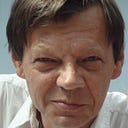Lessons learnt from Eliyahu Goldratt the founder of the Theory Of Constraints and author of bestseller “The Goal”
I started working with Eliyahu Goldratt when I was 26. The bestseller-to-be The Goal had just been published. This was in 1985, I had just joined a start-up called Creative Output and Eli was one of the 4 founders. The company sold “OPT”, a scheduling software that managed the flow of production in factories in a revolutionary way…the Theory Of Constraints Way.
34 years later I have implemented the Theory Of Constraints (TOC) ideas over 280 times in organizations in over 25 countries and in a variety of industries. Some of my better-known clients are: McDonald’s, Louis Vuitton, Embraer, Siemens, GSK, Air France, Safran and Ariane rockets
Throughout this journey Eliyahu Goldratt had an enormous impact on me. Here are some of my key learnings.
Systems are not balanced … they have bottlenecks
The realization that factories are unbalanced and therefore have bottlenecks. This simple but powerful idea led me many years later to choose a TOC inspired logo for the TOC based company I created in 2005.
Focus
Focus: learning not to do what one should not do. Protecting one’s daily schedule from the horrors of bad multitasking (avoid continual mobile phone interruptions). Stop starting and start finishing.
To buffer or not to buffer
The conflict between DBR and Lean Manufacturing. Drum-Buffer-Rope (DBR) is the scheduling mechanism proposed by TOC to manage production when there is a bottleneck. The main difference is that DBR recommends managing a Buffer of work whereas in a Lean solution you would not accept the existence of a buffer of products. In fact both schools of thought are correct, it depends on the context.
Marketing often absent in B-to-B
The fundamental importance of marketing in business-to-business industries and the realization that very few B-to-B companies do enough marketing. Eli wrote the book The Goal as a marketing tool, so how does one do TOC marketing in today’s internet dominated world?
Managing projects properly with Critical Chain
Critical Chain Project Management (CCPM) is an extraordinarily powerful tool to manage individual projects and portfolios of projects by a frontal and honest management of uncertainty. It enables one to finish projects about twice as fast and nearly always on time. It dramatically improves visibility. It also has a very positive impact on the quality of life of the actors.
Logic…thinking is hard work
The strange world of logic: Thinking Processes, Goal Trees and other dangerous habits. I feel I still have a lot to learn here. I have been trained by Bill Dettmer (the recognized world expert) in the Logical Thinking Process. I use this with my teams often to design a logical growth strategy based on logic. Once you start doing this you realize that logic is rare in organizations.
Never waver
He also taught me how and why to never waver on your TOC journey.
A TOC + Lean cocktail
The other major influencer on my work was Taiichi Ohno, one of the key figures of “Lean” or the “Toyoya Way”. Indeed, I have spent most of my life mixing cocktails of essentially Lean and Theory Of Constraints to help my clients improve their performance.
You can watch a 7-minute video in which I summarize what I learnt from Eliyahu Goldratt here:
To conclude, just one of Eliyahu Goldratt’s many though provoking quotes:
“Tell me how you measure me and I’ll tell you how I will behave.”
